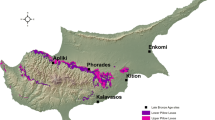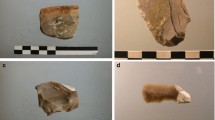Abstract
Provenancing of ancient ceramics is a highly important scientific tool for archaeological studies. In general, ceramics are not made from the original clay as it is found in deposits. To produce the needed physical properties in the finished product, the clay has to be either tempered by adding sands or biological materials, or levigated, to remove the coarse fraction. Thus, the chemical composition of the finished ceramic differs from the composition of the original clay bed. To overcome this obfuscation, any information that can be gained about the temper is useful. In a small series, several pieces of ceramic were produced from known clay and tempers and the resulting ceramics analysed by neutron activation analysis (NAA). As many attempts to physically separate the temper from the clay matrix have failed, μ-spot analysis of temper inclusions was performed at the microbeam particle induced X-ray Emission (μ-PIXE) facility in Rossendorf and with laser ablation inductively coupled plasma mass spectroscopy (LA-ICP-MS) at the Aberystwyth University in Wales. It could be shown that from a small number of measurements, a general impression of the temper used could be gained. Furthermore the μ-spot methods and the bulk data gained from INAA are highly comparable, extending the set of elements that can be measured. With this information, the influence of the temper on the bulk composition of the finished product can be estimated, which potentially adds crucial information to subsequent dilution calculations.






Similar content being viewed by others
References
Perlman I, Asaro F (1969) Pottery analysis by neutron activation. Archaeometry 11:21–52
Steinhauser G, Sterba JH, Bichler M, Huber H (2006) Neutron activation analysis of mediterranean volcanic rocks—an analytical database for archaeological stratigraphy. Appl Geochem 21(8):1362–1375
Peltz C, Schmid P, Bichler M (1999) INAA of Aegaean pumices for the classification of archaeological findings. J Radioanal Nucl Chem 242:361–377
Peltz C, Bichler M (2001) Classification of archeologically stratified pumice by INAA. J Radioanal Nucl Chem 248:81–87
Bichler M, Peltz C, Sortino F (1999) A comparison of new techniques for the determination of minor and trace elements in volcanic gases by NAA. Czech J Phys 49:347–354
Neff H, Bishop RL, Sayre EV (1989) More observations on the problem of tempering in compositional studies of archaeological ceramics. J Archaeol Sci 16(1):57–69
Neff H, Bishop RL, Sayre EV (1988) A simulation approach to the problem of tempering in compositional studies of archaeological ceramics. J Archaeol Sci 15(2):159–172
Cogswell J, Neff H, Glascock M (1996) The effect of firing temperature on the elemental characterization of pottery. J Archaeol Sci 23(2):283–287
Jones RE (1986) Greek and Cypriot pottery: a review of scientific studies, vol 1. Fitch Laboratory Occasional Paper, Athens
Sterba JH, Mommsen H, Steinhauser G, Bichler M (2009) The influence of different tempers on the composition of pottery. J Archaeol Sci 36:1582–1589
Mommsen H, Sjöberg BL (2007) The importance of the ‘Best Relative Fit Factor’ when evaluating elemental concentration data of pottery demonstrated with Mycenaean sherds form Sinda, Cyprus. Archaeometry 49(2):359–371
Mommsen H, Kreuser A, Weber J (1988) A method for grouping pottery by chemical composition. Archaeometry 30(1):47–57
Beier T, Mommsen H (1994) Modified Mahalanobis filters for grouping pottery by chemical composition. Archaeometry 36(2):287–306
Goren Y, Mommsen H, Klinger J (2011) Non-destructive provenance study of cuneiform tablets using portable X-ray fluorescence (pXRF). J Archaeol Sci 38(3):684–696
Tschegg C, Hein I, Ntaflos T (2008) State of the art multi-analytical geoscientific approach to identify Cypriot bichrome wheelmade ware reproduction in the Eastern Nile delta (Egypt). J Archaeol Sci 35(5):1134–1147
Pearce NJG, Denton JS, Perkins WT, Westgate JA, Alloway BV (2007) Correlation and characterisation of individual glass shards from tephra deposits using trace element laser ablation ICP-MS analyses: current status and future potential. J Quatern Sci 22(7):721–736
Pearce NJG, Perkins WT, Westgate JA, Gorton MP, Jackson SE, Neal CR, Chenery SP (1997) A compilation of new and published major and trace element data for NIST SRM 610 and NIST SRM 612 glass reference materials. Geostand Newsl 21:115–144
Pearce NJG, Westgate JA, Perkins WT, Preece SJ (2004) The application of ICP-MS methods to tephrochronological problems. Appl Geochem 19:289–322
Pearce NJG, Eastwood WJ, Westgate JA, Perkins WT (2002) Trace-element composition of single glass shards in distal Minoan tephra from SW Turkey. J Geol Soc London 159:545–556
Perkins WT, Pearce NJG (1995) In: Potts PJ, Bowles JFW, Reed SJB, Cave (eds) Microprobe techniques in the earth sciences. The Mineralogical Society, London, pp 291–325
Herrmann F, Grambole D (1995) The new Rossendorf nuclear microprobe. Nucl Instrum Methods Phys Res Sect B Beam Interact Mater Atoms 104(1–4):26–30
Campbell JL, Hopman TL, Maxwell JA, Nejedly Z (2000) The Guelph PIXE software package III: alternative proton database. Nucl Instrum Methods Phys Res Sect B Beam Interact Mater Atoms 170(1–2):193–204
Taylor SR, McLennan SM (1985) The continental crust: its composition and evolution. Monographie: geoscience texts. Blackwell Scientific Publications, Oxford
Acknowledgments
The μ-PIXE measurements used in this work were financed by the Integrated Activity “Support of Public and Industrial Research by using ion beam Technology” (SPIRIT, EU Project number 227012).
Author information
Authors and Affiliations
Corresponding author
Rights and permissions
About this article
Cite this article
Sterba, J.H., Munnik, F. & Pearce, N.J.G. Raising the temper—μ-spot analysis of temper inclusions in experimental ceramics. J Radioanal Nucl Chem 291, 25–35 (2012). https://doi.org/10.1007/s10967-011-1208-6
Received:
Published:
Issue Date:
DOI: https://doi.org/10.1007/s10967-011-1208-6




